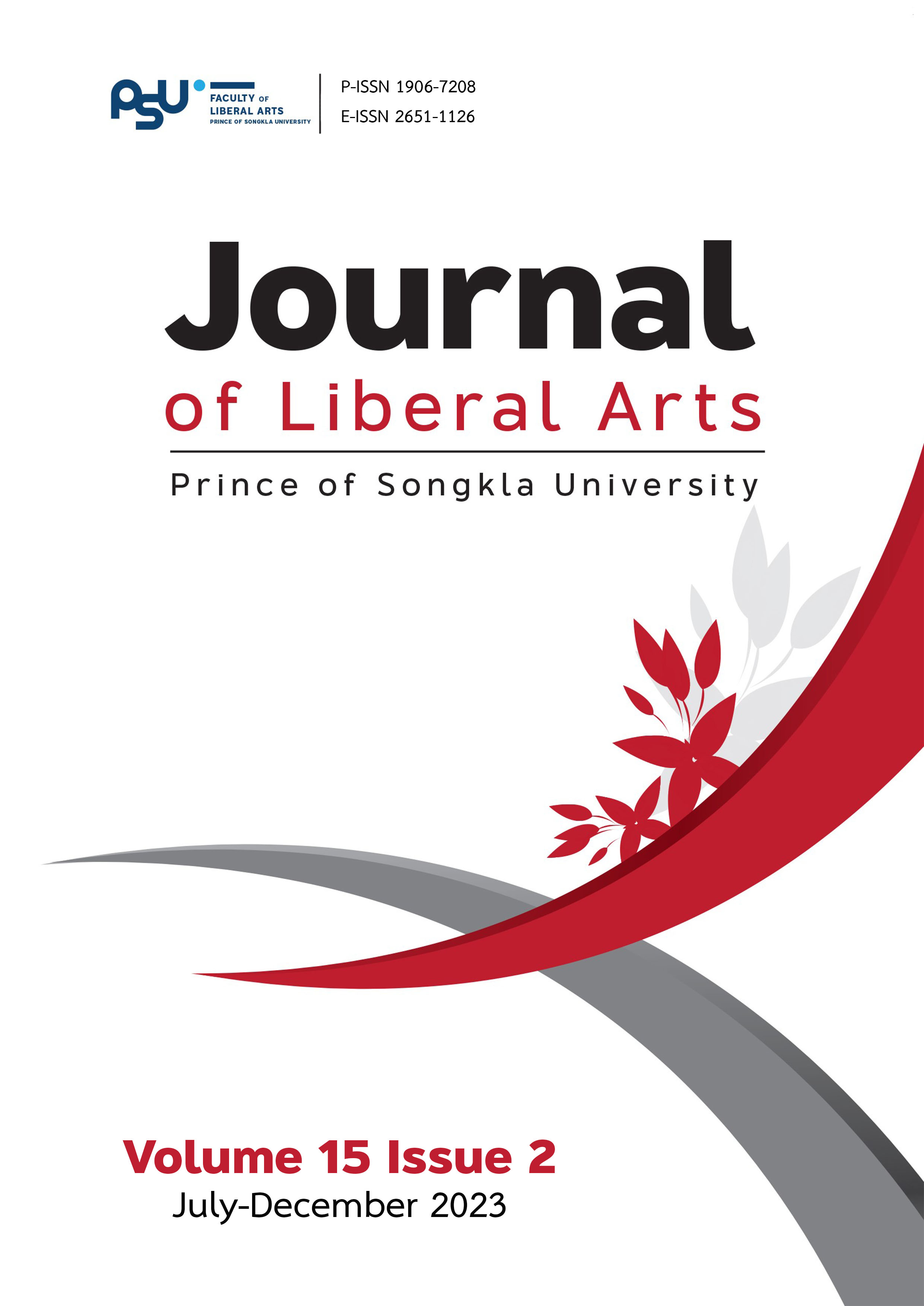การพัฒนาสินค้าทางวัฒนธรรมจากศิลปะลวดลายลูกปัดโบราณภาคใต้
DOI:
https://doi.org/10.14456/jlapsu.2023.10คำสำคัญ:
ลูกปัดโบราณ , การออกแบบ , สินค้าทางวัฒนธรรมบทคัดย่อ
การศึกษาวิจัยครั้งนี้มีจุดมุ่งหมายเพื่อศึกษาองค์ความรู้เกี่ยวกับลูกปัดโบราณภาคใต้ ประเทศไทย ออกแบบและพัฒนาลวดลายผ้าคลุมไหล่อเนกประสงค์ โดยใช้วิธีการศึกษารวบรวมข้อมูลจากหลักฐานทางโบราณวัตถุการเก็บข้อมูลจากหนังสือ เอกสารที่เกี่ยวข้อง และการสัมภาษณ์เจ้าหน้าที่ในพิพิธภัณฑ์ ผู้มีความรู้เกี่ยวกับลูกปัด และ
นักสะสมลูกปัด ในจังหวัดสงขลาและกระบี่ จำนวน 13 ท่าน นำข้อมูลที่ได้จากการศึกษามาเป็นฐานความรู้ เชื่อมโยงไปสู่กระบวนการในการสร้างสรรค์ลวดลายและพัฒนาเป็นผ้าคลุมไหล่อเนกประสงค์ และการประเมินผลความพึงพอใจของกลุ่มตัวอย่างนักท่องเที่ยว จำนวน 400 คน ที่มีต่อผ้าคลุมไหล่อเนกประสงค์ โดยใช้แบบสอบถามออนไลน์ ผลการวิจัยพบว่า ลูกปัดโบราณในภาคใต้ที่มีความโดดเด่น สะท้อนถึงบริบทของภาคใต้มีสามชนิด ได้แก่ ลูกปัดลูกลม ลูกปัดสุริยะเทพ และลูกปัดเปลือกหอย ผู้วิจัยได้นำอัตลักษณ์ของลูกปัดทั้งสามชนิดมาสร้างสรรค์ลวดลายและพัฒนาเป็นผ้าคลุมไหล่อเนกประสงค์ ผลการวิเคราะห์ระดับความคิดเห็นของนักท่องเที่ยวที่มีต่อสินค้าทางวัฒนธรรม พบว่า มีความพึงพอใจต่อผ้าลวดลายสุริยะเทพมากที่สุด รองลงมา คือ ผ้าลวดลายลูกปัดลูกลม และผ้าลวดลายลูกปัดเปลือกหอย ตามลำดับ
เอกสารอ้างอิง
Borell, B., Bellina, B., & Chaisuwan, B. (2014). Contacts between the upper Thai-Malay peninsula and the Mediterranean world. In R. Nicolas & A. M. Stephen. (Eds.), Before Siam: Essays in art and archaeology of pre-modern Thailand and its neighbouring regions (pp. 98-117). River Books.
Glover, I. C., Jahan, S. H., Revire, N., & Murphy, S. A. (2014). An early northwest Indian decorated bronze bowl from Khao Sam Kaeo. In R. Nicolas & A. M. Stephen. (Eds.), Before Siam: Essays in art and archaeology of pre-modern Thailand and its neighbouring regions (pp. 90-97). River Books.
Gosh, S. (2018). Sailing to Suvarnabhumi: View from Jatakas and inscriptions, Suvarnabhumi. In P., Bunchar & T.Somchet (Eds.), The golden land, the new finding for Suvanabhumi Terra Incognita (pp.17-22). Sirivatana Interprinting.
Jedeetha, N. (2015). Kan sueksa khwam samphan rawang india boran kap suwannaphum samai thawarawadi: Sueksa phan lukpat india nai laeng boranna khadi phak klang lae phak tai nai prathet thai. (in Thai) [Relationship between ancient India and Suvarnabhumi in Dvaravati period: A case study of Indian beads in archaeological site in the southern and central region of Thailand] [Unpublished master’s thesis]. Chiangmai University. ThaiThesisDatabase.
Kaewareelap, S., & Kritsanapan, P. (2018). Krabuan kan sang san khonlechan pha batik. (in Thai) [The creative process of Batik’s collection]. Veridian E-Jouanal, Silpakorn University, 11(3), 3245-3260.
Kednaramol, J. (2012). Kan sueksa lukpat phak tai su kan okbaep sunsukphap samrap phu sung ayu. (in Thai) [The study of bead in the southern of Thailand for the elderly healthcare center interior design project] [Unpublished master’s thesis.] Silpakorn University. ThaiThesisDatabase.
Lertcharnrit, T. (2011). Kan chatkan sapphayakon watthanatham. (in Thai) [Cultural resource management]. The Princess Maha Chakri Sirindhorn Anthropology Centre.
Nimsamer, C. (2011). Ong prakop khong sin. (in Thai) [Composition of art]. Amarin Printing.
Pongpaiboon, S. (1986). Saranukrom watthanatham phak tai. (in Thai) [The Encyclopedia of Southern Thai Culture]. Amarin Printing.
Rattanapan, C. (2018). Kan nam sinpa watthanatham phak tai ma sarang naeo khwamkhit nai kan okbaep khong thi raluek. (in Thai) [The design process of souvenirs by using the inspiration of arts and culture in the south of Thailand]. Walailak Abode of Culture Journal, 18(1), 119-136.
Santajit, W., Ridhikerd, A., & Bureekhampun, S. (2019). Kan sueksa attalak thang watthanatham manora phuea prayuk chai nai kan okbaep khrueangpradap. (in Thai) [A study of Manora’s cultural identity to be applied in jewelry design]. Journal of Industrial Education, 18(2), 127-139.
Suttimusig, J. (2011). Ong prakop sin. (in Thai) [Composition]. Retrieved April 29, 2023, from http://gotoknow.org/posts/417795.
Suwacharapinan, S., Kaittiweerasak, T., & Littisorn, R. (2012, May 25). Sanyawitthaya kan thot rahat lae kanprayuk attalak thai phuea pen naeo thang kan okbaep. (in Thai) [Semiology: decoding and applying Thai identities for design guidelines.] [Paper Presentation]. Proceedings of the Built Environment Research Associates Conference, Faculty of Architecture and Planning, Thammasat University, Thailand.
ดาวน์โหลด
เผยแพร่แล้ว
รูปแบบการอ้างอิง
ฉบับ
ประเภทบทความ
สัญญาอนุญาต
ลิขสิทธิ์ (c) 2023 Paweekorn Suraban, Pornpan Khemakhunasai, Natthapong Chitniratna

อนุญาตภายใต้เงื่อนไข Creative Commons Attribution-NonCommercial-NoDerivatives 4.0 International License.
ลิขสิทธิ์บทความเป็นของผู้เขียน แต่วารสารศิลปศาสตร์ มหาวิทยาลัยสงขลานครินทร์ ขอสงวนสิทธิ์ในการเป็นผู้ตีพิมพ์เผยแพร่เป็นครั้งแรก






